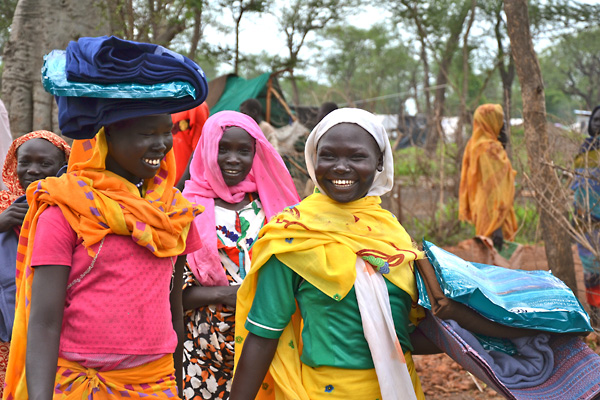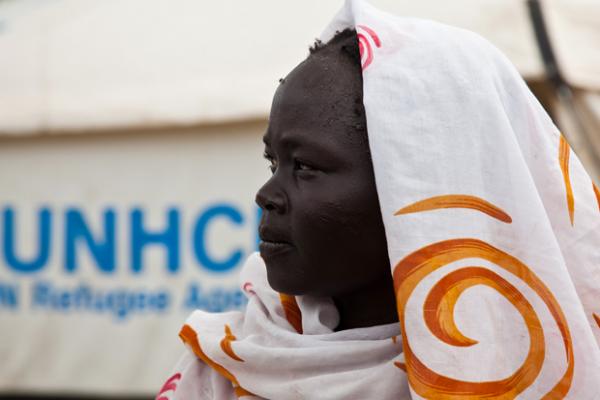The human cost of conflict: refugee crisis in South Sudan
“More than ever, Sudanese refugees need the support of the international community to meet their basic needs and enjoy safe asylum.” Cosmas Chanda, UNHCR Representative in South Sudan, gives an update on the refugee situation in South Sudan since The Elders' visit last July and the efforts of humanitarian staff to provide shelter, clean water and medical treatment to the thousands of people who had fled their homes.
It is almost nine months since the visit of The Elders to South Sudan. Last July, as the country marked its first year of independence, my office had the distinct honour of accompanying them on a trip to the refugee camps in Upper Nile state, where UNHCR and other agencies were coping with an unprecedented influx of refugees. In Yusuf Batil camp, after listening to people who had fled fighting in Sudan and witnessing the efforts of our humanitarian staff, Archbishop Tutu told us: “You have put a smile on God’s face.”
Desmond Tutu and fellow Elders with UNHCR aid workers in Yusuf Batil refugee camp, July 2012.
The refugees had fled fighting in South Kordofan and Blue Nile, two territories that straddled the frontline of Sudan’s civil war and had special status in the 2005 Comprehensive Peace Agreement (CPA). After South Sudan’s independence in 2011, the conflict that erupted in the two Sudanese states between SPLM-N rebels and the Sudanese Armed Forces triggered sizeable population displacements towards South Sudan (some 30,000 refugees also fled to Ethiopia). In remote areas of this newly independent state, one of Africa’s largest refugee emergencies unfolded. Since then we have faced major public health issues in the camps while the flow of new arrivals continued.
The continuing conflict in Blue Nile and South Kordofan does not augur well for an imminent end to the exile of Sudanese refugees. More than ever, they need the support of the international community to meet their basic needs and enjoy safe asylum.
Refugee crisis in South Sudan
Around April last year, the seasonal rains were about to start. We were preparing to relocate refugees from flood-prone areas to a new camp, Yusuf Batil, when suddenly we had an entirely unexpected influx of 32,000 refugees fleeing the fighting in Blue Nile. The scale was unprecedented: until then, refugees had arrived in unpredictable numbers ranging each week from double-digit trickles to groups of several hundred to waves of several thousand.
 Yusuf Batil – the third of four refugee camps in Upper Nile state – filled up quickly. The population swelled from 4,000 to more than 36,000 refugees over a four-week period during June 2012, just as the seasonal rains were beginning. UNHCR and other agencies worked around the clock to clear the site, erect tents and establish basic services while welcoming the refugees who had mostly travelled together in communities from different villages.
Yusuf Batil – the third of four refugee camps in Upper Nile state – filled up quickly. The population swelled from 4,000 to more than 36,000 refugees over a four-week period during June 2012, just as the seasonal rains were beginning. UNHCR and other agencies worked around the clock to clear the site, erect tents and establish basic services while welcoming the refugees who had mostly travelled together in communities from different villages.
The refugees had endured the worst forms of trauma and hardship. They had spent weeks travelling on foot and hiding in forests, mountains and caves as fighting raged in the Bau region of Blue Nile state. They carried whatever food they could, mostly sorghum, or helped themselves from fields and granaries in abandoned villages.
By the time they crossed the border, they had gone for long periods without proper food or clean drinking water. They skimmed water from open sources where livestock drank and even defecated. When food ran out, the refugees ate wild roots and boiled the bitter leaves of the lalob, or soap berry tree. People died or were abandoned on the gruelling journey, particularly children, older persons and the infirm. Livestock, a prime source of wealth, perished or had to be deserted, too. This is the state the refugees were in when The Elders visited Yusuf Batil in July 2012.
Malnutrition, meningitis, malaria: health problems in the camps
By August, Yusuf Batil camp was facing a public health emergency. The combination of dense population concentrations, poor hygiene practices and weakened immune systems became a catalyst for infection and spread of diseases.

Flooding in Yusuf Batil refugee camp, August 2012. Photo: Terrie Nekesa Ongaro | UNHCR
With the rains came swarms of mosquitoes; much of South Sudan is malaria-endemic. In the refugee camps, the threat of water-borne disease loomed large as pools of stagnant muddy water dominated the landscape. In Yusuf Batil camp we saw the destructive effects on small children of having undergone extreme physical exertion for long periods without proper food and clean drinking water. Malnutrition rates were alarming, particularly among very young children (50 per cent of the population in that camp is under 11 years old) and older people. In September, we faced a Hepatitis E outbreak that killed more than two dozen people.
The rains brought overland transportation to a virtual standstill. Maban County, where Yusuf Batil is located, has virtually no infrastructure, industry or local technical capacity, so all humanitarian aid has to be brought in from outside. With land routes cut off by the rains, goods had to be airlifted. We had to pool resources and prioritise activities on a daily basis according to the most critical needs.
Despite these logistical setbacks, aid workers went into battle to save refugees’ lives and prevent diseases spreading further. We set up supplementary feeding programmes and oral rehydration points; distributed extra blankets and mosquito nets. As it became evident that refugees tended towards seeking traditional healers first, community outreach and tent-to-tent visits became cornerstones of the campaign. By the end of the year we were observing improvements in the health and nutrition situation of refugees, although the situation remained fragile.

Refugees carrying relief packages, Upper Nile State, August 2012. Photo: Terrie Nekesa Ongaro | UNHCR
Tensions with host communities
Predictably, the massive presence of refugees in Maban County led to tensions with host communities. The region is remote and sparsely populated, but with close to 115,000 refugees – anecdotal accounts contend that refugees outnumber locals by five-to-one – issues like competition for natural resources have been fuelling conflicts. Refugees cut trees for fuel wood as well as for sale and construction. They own large herds of livestock, inevitably encroaching on grazing grounds, cultivated land and water sources.
We are working with local authorities, members of refugee and host communities, and humanitarian actors to mitigate these tensions and develop projects benefiting the local population. For example, a surgical theatre has been established at the county hospital in Bunj, treating refugees and host communities alike. Health clinics in refugee camps are open to members of the host community, as are water tap stands. Boreholes have been drilled in local villages and seeds and tools distributed to both local and refugee populations.

Refugees at Jamam refugee camp, August 2012. Photo: Terrie Nekesa Ongaro | UNHCR
Recent developments and looking ahead
Following the Elders’ visit, the flow of new arrivals into Upper Nile State carried on albeit at a reduced pace. By the end of the first quarter of 2013, fighting in both Southern Kordofan and Blue Nile continued to provoke sporadic movements of refugees such that the population of Sudanese refugees in South Sudan surpassed the 190,000 mark. In both Unity and Upper Nile, agencies are prepositioning supplies of food and relief items, while standing ready to respond in the event of a fresh influx of refugees.
We anticipate that the refugee operation will continue to require massive investment by the international community in order to maintain access routes and camp infrastructure, deliver timely life-saving assistance and basic services, and provide the refugees with legal and social protection.
I must conclude by lauding the exceptional generosity of the Government and people of the Republic of South Sudan who, despite facing colossal challenges linked to nation building in a newly-independent state, have nonetheless met their international obligations providing asylum to refugees from Sudan and elsewhere in the region who have lost the protection of their own government.
Cosmas Chanda, UNHCR Representative in South Sudan


